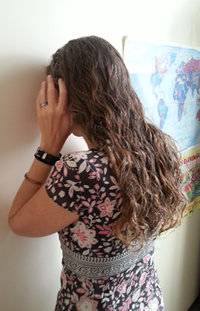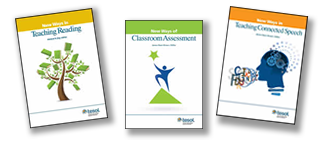Lesson Plan: I Can Explain...
by Sarah Sahr
 How many times have you asked students to talk about a certain topic in class and then… nothing, complete silence? Occasionally, students simply don’t know how to begin a conversation. Sentence starters are usually good, but that requires a bit of reading. For a truly authentic speaking activity, we really need students to focus on what they are going to say (and, as with all speaking activities, there is always a little bit of listening).
How many times have you asked students to talk about a certain topic in class and then… nothing, complete silence? Occasionally, students simply don’t know how to begin a conversation. Sentence starters are usually good, but that requires a bit of reading. For a truly authentic speaking activity, we really need students to focus on what they are going to say (and, as with all speaking activities, there is always a little bit of listening).
I also like to allow students to have a little bit of support when trying to speak extemporaneously. In this activity, I allow students to have a “cheat sheet” to help them voyage their way through a conversation (and the cheat sheet presents an opportunity for a little bit of writing, the other production skill). In allowing students to build their own scaffold, this lesson plan lets students practice authentic conversation with a little bit of support. In the end, this lesson plan will ask students to listen, write, and speak; three out of four skills… not bad!
Consequently, this will be a great opportunity for students to practice how to ask clarifying questions. See the Conversation step in this lesson plan for more details.
Disclaimer: You’ll need enough computers for each student to have his or her own. You’ll also need access to You Tube.
| Materials: Computers with Internet access; YouTube; photos of complex dished food like apple pie, palak paneer, lasagna, etc. |
| Audience: Secondary students and adults, all proficiency levels |
Objective: Students will be able to
• construct “how to” notes based on a YouTube video,
• paraphrase the steps needed to make a favorite food, and
• ask clarifying questions to their partner regarding the steps needed to make the favorite food |
| Outcome: Students will talk about how to make their favorite food |
| Duration: 6 minutes |
Lesson Preparation
Talk with the overseer of the computer lab in your institution. Make sure there are enough working computers for your class and that each computer has headphones. Also check that there isn’t a firewall blocking YouTube.
Introduction
Pass some photos around the room of complex dishes to make. Use food items that take a great deal of time to prepare: apple pie, palak paneer, lasagna, ceviche, injera, bulgogi, pho, etc. Ask students if they would be able to explain to a classmate, how do you make these items?
Field Trip! Let students know they are about to learn. Gather your things… we are walking down the hall… to the computer lab.
Building a Scaffold
Please only allow 20 minutes for this part of the activity. Sometimes, students get “stuck” on YouTube and can’t leave. No cat videos, please.
Students should choose a food they would like to watch being made. By simply searching on YouTube for any food item, thousands of videos come up. “Apple Pie”: 289,000 hits, “Palak Paneer”: 11,000 hits, “Bolgogi”: 18,700 hits. For the sake of time, the video they choose to watch should be no more than 5 minutes.
While students watch their videos, with head phones on, they should write down key points on how to make the dish. Students will be able to use these notes when talking with their partner.
Practice
 After the 20 minutes have been used viewing the videos, students should practice how they are going to present the dish to their partner. One of the greatest ways to do this is to have each student stand up, facing a wall. In using hands to cup ears and speaking very softly into the wall, students can hear their voice and make adjustments to inflection, tone, cadence, and the like (see photo). Sequencing is key to this conversation. Make sure students practice going through their key points in order. And, lastly, consider wall space; it might be best to have students utilize the hallway, if possible, for this practice. Allow for 10 minutes of practice.
After the 20 minutes have been used viewing the videos, students should practice how they are going to present the dish to their partner. One of the greatest ways to do this is to have each student stand up, facing a wall. In using hands to cup ears and speaking very softly into the wall, students can hear their voice and make adjustments to inflection, tone, cadence, and the like (see photo). Sequencing is key to this conversation. Make sure students practice going through their key points in order. And, lastly, consider wall space; it might be best to have students utilize the hallway, if possible, for this practice. Allow for 10 minutes of practice.
Conversation
Return everyone to the classroom. Have students pair up as they enter. Take a very quick moment to review some question starters on clarification. For example:
- What do you mean?
- I don’t think I understand what you are saying.
- Why would you do that?
- So you have to blanch the tomatoes… what’s blanch?
- How many minutes do you bake the bread?
- Could you repeat that?
I’d also ask students to predict what questions they might be asked based on their explanations. Write some of these question starters on the board.
Remind the students that they have a cheat sheet to help them. Let them know it’s important to cover all points they wrote down on the paper. (It must be important if they wrote it down.) Remember sequencing! Let them talk for as long as possible.
Closure
If time allows, students can talk about the experience of having these kinds of self-built scaffolded conversations. Make sure this closer activity isn’t about the food, but more about the conversation prep and execution. What could have been different?
____________________
Sarah Sahr works at TESOL and is currently pursuing her doctorate in education administration and policy at the George Washington University. Her professional career has taken her all over the world, most notably as a Peace Corps Volunteer in Ethiopia and as a traveling school teacher/administrator with Ringling Bros. and Barnum & Bailey circus. Sarah is also a certified ashtanga yoga instructor and has managed an eco-lodge in Chugchilan, Ecuador.
TESOL Blogs
Interested in writing a blog for TESOL?
Contact
Tomiko Breland with your idea or for details.
Check out the latest TESOL Blogs:
|
Teaching and Learning Online: Part Two: Putting the Pedagogy First, by Andy Curtis
 After posting the first blog in this series on August 14, I received an e-mail asking about the name of this blog: Teaching and Learning Online (TLO). As we are all language teachers, in one way or another, the reader asked why the name was not, for example, Online Learning and Teaching. That was a very good question, so I thought it would be useful to explain my belief that “online” should “come at the end.” After posting the first blog in this series on August 14, I received an e-mail asking about the name of this blog: Teaching and Learning Online (TLO). As we are all language teachers, in one way or another, the reader asked why the name was not, for example, Online Learning and Teaching. That was a very good question, so I thought it would be useful to explain my belief that “online” should “come at the end.”
As a TESOL professional of color, I first heard the phrase “people of color” shortly after Martin Luther King Jr referred to “citizens of color” in 1963. And although the phrase can still spark a lively debate even today, the phrase “forefronted” being people and citizens first, and being “colored” second. Read More. |
|
The Rhetorical Situation: An Interactive Classroom Activity, by Elena Shvidko
 The concept of rhetorical situation is not easy to grasp for even the most advanced ESL writers. Even when they seem to understand it conceptually, they still may have a hard time applying it to their own writing. The interactive classroom activity that I include in today’s entry provides examples and application of purpose, audience, genre, stance, and media, and it can also serve as a great review of material that you addressed in class about the topic. Read More. The concept of rhetorical situation is not easy to grasp for even the most advanced ESL writers. Even when they seem to understand it conceptually, they still may have a hard time applying it to their own writing. The interactive classroom activity that I include in today’s entry provides examples and application of purpose, audience, genre, stance, and media, and it can also serve as a great review of material that you addressed in class about the topic. Read More.
|
|
Organization Tools for Every Teacher, by Tara Arntsen
 While I was teaching internationally, none of my schools ever had their own software to help teachers with their record keeping (for things like grades and attendance), but there are a number of free sites that help teachers do just that. From what I’ve found, it seems like Engrade, Edmodo, and Schoology are three of the best/most popular. Read More. While I was teaching internationally, none of my schools ever had their own software to help teachers with their record keeping (for things like grades and attendance), but there are a number of free sites that help teachers do just that. From what I’ve found, it seems like Engrade, Edmodo, and Schoology are three of the best/most popular. Read More.
|
|
TESOL Symposium and Annual CAMELTA Congress: An Overview, by Christine Coombe
 As part of my summer vacation, I had the great pleasure of serving as a plenary speaker at the TESOL Symposium on K–12 Teacher Development and Training on August 12, 2012 and the 12th Annual CAMELTA Congress on August 13–14, 2013. This 1-day event planned jointly with TESOL International Association and CAMELTA (Cameroon English Language and Literature Teachers Association) and held at the Catholic University of Central Africa, Ekounou Campus in Yaounde, Cameroon, provided a unique opportunity for teachers, teacher trainers and administrators in Cameroon, Africa, and EFL contexts worldwide to explore effective policies and practices in K–12 teacher development. Read More. As part of my summer vacation, I had the great pleasure of serving as a plenary speaker at the TESOL Symposium on K–12 Teacher Development and Training on August 12, 2012 and the 12th Annual CAMELTA Congress on August 13–14, 2013. This 1-day event planned jointly with TESOL International Association and CAMELTA (Cameroon English Language and Literature Teachers Association) and held at the Catholic University of Central Africa, Ekounou Campus in Yaounde, Cameroon, provided a unique opportunity for teachers, teacher trainers and administrators in Cameroon, Africa, and EFL contexts worldwide to explore effective policies and practices in K–12 teacher development. Read More.
|
TESOL Bookstore

Looking for classroom ideas for Monday morning?

These popular books in the New Ways series are now updated and revised, featuring
-
New activities inspired by state-of-the art developments in teaching English learners
-
Expanded resources needed for today’s classroom
-
More of what made the first editions become best sellers: classroom-ready activities contributed by ESL and EFL reading teachers for ESL and EFL reading teachers
New Ways in Teaching Reading, revised
Richard R. Day, Editor
New Ways of Classroom Assessment, revised
James Dean Brown, Editor
New Ways of Teaching Connected Speech
James Dean Brown, Editor
Browse the entire New Ways series
Look for more New Ways revisions coming in late 2013:
New Ways in Teaching Writing, revised
Denise Mussman, Editor
New Ways in Teaching Business English
Evan Frendo and Clarice Chan, Editors